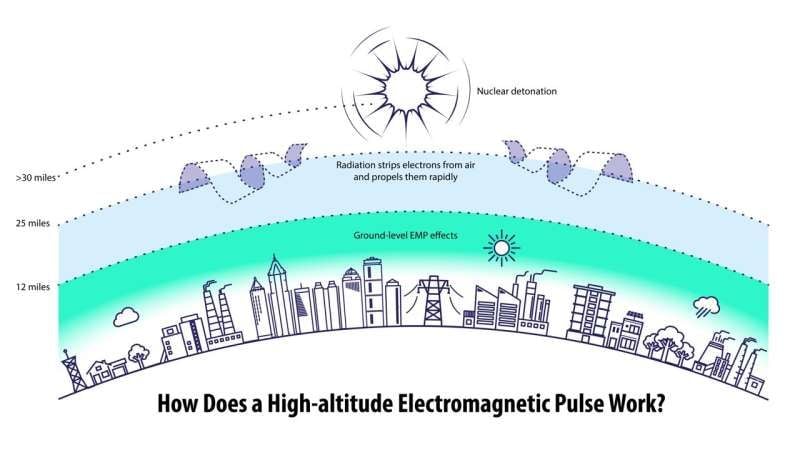Should Power Plants Worry About Electromagnetic Pulses?
A study at the Oak Ridge National Laboratory investigates the susceptibility of power plants to high-altitude electromagnetic pulses.
Regarding the security and safety of power plants, high-altitude electromagnetic pulses (EMPs) have emerged as a critical area of concern. These EMPs, emanating from nuclear detonations in the atmosphere, unleash electromagnetic radiation with far-reaching impacts on electronic and power systems.
Power plant. Image used courtesy of USGS
As technology advances, increasing reliance on sensitive semiconductors and lower-voltage operations heightens the susceptibility of power systems to these pulses. In response to this escalating challenge, researchers at the Oak Ridge National Laboratory (ORNL) have embarked on a project to understand and mitigate high-altitude EMPs’ risk to power plants.
What Are EMPs?
EMPs can have devastating effects on electronic and power systems. For example, if a nuclear weapon were detonated hundreds of miles above the Earth, it would emit gamma rays that interact with air molecules, stripping them of electrons. These electrons would be drawn to the Earth’s magnetic poles in a corkscrew pattern, releasing electromagnetic radiation that could damage systems within its line of sight. This radiation would not directly harm people on the ground but could couple to power, electronic, and communication systems, producing large spikes in voltage or current that can destroy equipment unless it is specially protected.
High-altitude EMPs pose a notable threat to modern power systems. Image used courtesy of ORNL
The threat posed by high-altitude EMPs to power plants is multifaceted. EMPs can rapidly progress through multiple pulse stages, each impacting power transformers, instruments, and power system operations differently. The first pulse stage, known as the E1 phase, occurs almost instantaneously after the nuclear detonation and can cause significant damage to electronics and communication systems. The E2 phase, similar to a lightning strike, can further damage systems already weakened by the E1 phase. Finally, the E3 phase, resembling a geomagnetic storm, can have long-lasting effects on power grid infrastructure.
As modern electronic equipment relies more heavily on sensitive semiconductors and operates at lower voltages, it is more vulnerable to EMPs than older equipment. For this reason, research into immunity to EMPs has become a hot-button topic in recent years.
The ORNL EMP Research
Researchers at the Department of Energy’s Oak Ridge National Laboratory have spearheaded a project to understand how EMPs could threaten power plants. Collaborating with Lawrence Livermore National Laboratory and the University of Tennessee Center for Ultra-wide-area Resilient Electric Energy Transmission Networks (CURENT), the team has been investigating how EMPs could enter a power plant and the damage they could inflict.
A key part of their research involves simulating the effects of EMPs on power plant equipment. For instance, they studied the vulnerability of equipment connected to long cables, as these can act as antennas for electromagnetic energy. The researchers injected low-level signals into power electronics like inverters and programmable logic controllers to understand how these components channel electromagnetic energy and what exposure level can cause damage.
Moreover, the team developed a simulation tool to help utilities analyze their specific configurations and predict EMP impacts. This tool also generated general recommendations for enhancing surge protection equipment, grounding, and shielding. It highlighted that traditional grounding methods sufficient for lightning strikes might be inadequate against EMPs.
The study found that lightning protection was inadequate against EMPs. Image used courtesy of Bradbury Science Museum
The research underscored the vulnerability of basic or low-voltage components critical to electric generation. Cables and wires can pick up electromagnetic energy and deliver it to attached hardware, rapidly overloading the voltage capacity of simple motors and microelectronics essential for operations.
An EMP-Protected Future
As technology continues to evolve and global tensions rise, the importance of protecting power plants from high-altitude EMP threats becomes increasingly paramount. The research conducted by ORNL and its collaborators is significant to understanding and mitigating the risks EMPs pose to power plants. This research paves the way for further studies and the development of more robust protective measures, ensuring stable and secure power systems in the face of such unprecedented challenges.









